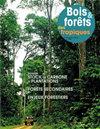Biodiversité et services écosystémiques en forêts tropicales : le rôle des affectations des terres forestières dans la région du Dja, Cameroun
IF 0.6
4区 农林科学
Q3 FORESTRY
引用次数: 0
Abstract
In central Africa, tens of millions of people depend on tropical forests for their livelihoods. The biodiversity of these ecosystems is unique and provides important ecosystem services (ES), which can vary depending on management strategies. For this PhD thesis, we assessed biodiversity and ecosystem services in the Dja landscape in Cameroon forests classified into three forest land allocations use: a protected area, an FSC-certified logging concession and three community forests. First, we assessed the forest conservation value based on the species richness and composition of two taxonomic groups, mammals and dung beetles. The largest and most threatened species were detected in the protected area and in the most remote areas in the logging concession, which are better preserved from human influence. In contrast, the community forests seemed to be particularly lacking in fauna and degraded due to their proximity to roads and villages, but these cover much smaller areas and still have a closed canopy. Secondly, interviews identifying the perceptions of ES supply showed that provisioning and cultural services are the most important ES for local populations, in contrast to regulating services which were barely mentioned. Among the former, bushmeat was the only service for which the forest supply is not sufficient for local populations. Thirdly, combining interviews and field surveys, we quantified the use by local populations of eight provisioning and cultural ES. We found that firewood and timber are used sustainably by local populations, whereas bushmeat hunting and consumption exceed sustainability thresholds. Reconciling wildlife conservation, food security, and sustainable hunting practices is a major challenge in central Africa. To address this challenge it is crucial to include all stakeholders in sustainable forest management strategies, in order to identify the social levers that can underpin behavioural changes among forest users.热带森林生物多样性和生态系统服务:喀麦隆Dja地区森林土地利用的作用
在非洲中部,数千万人依靠热带森林维持生计。这些生态系统的生物多样性是独特的,并提供重要的生态系统服务(ES),这可能因管理策略而异。在这篇博士论文中,我们评估了喀麦隆Dja森林景观的生物多样性和生态系统服务,将其分为三种森林土地分配用途:保护区,fsc认证的伐木特许权和三个社区森林。首先,基于哺乳动物和屎壳郎两个分类类群的物种丰富度和组成对森林保护价值进行了评价。在保护区和伐木特许权的最偏远地区发现了最大和最受威胁的物种,这些地区受到更好的保护,不受人类影响。相比之下,社区森林似乎特别缺乏动物,并且由于靠近道路和村庄而退化,但这些森林覆盖的面积要小得多,并且仍然有一个封闭的树冠。其次,访谈确定了对ES供应的看法,表明供应和文化服务对当地人口来说是最重要的ES,相比之下,监管服务几乎没有被提及。在前者中,丛林肉是唯一森林供应不足以满足当地人口的服务。第三,结合访谈和实地调查,我们量化了当地人口对8种供应和文化ES的使用情况。我们发现,当地居民可持续地使用木柴和木材,而丛林肉的狩猎和消费超过了可持续性阈值。协调野生动物保护、粮食安全和可持续狩猎行为是中非面临的一项重大挑战。为了应对这一挑战,必须将所有利益攸关方纳入可持续森林管理战略,以确定能够支持森林使用者行为改变的社会杠杆。
本文章由计算机程序翻译,如有差异,请以英文原文为准。
求助全文
约1分钟内获得全文
求助全文
来源期刊

Bois et Forets Des Tropiques
FORESTRY-
CiteScore
1.50
自引率
16.70%
发文量
31
审稿时长
>12 weeks
期刊介绍:
In 1947, the former Tropical Forest Technical Centre (CTFT), now part of CIRAD, created the journal Bois et Forêts des Tropiques. Since then, it has disseminated knowledge and research results on forests in intertropical and Mediterranean regions to more than sixty countries. The articles, peer evaluated and reviewed, are short, synthetic and accessible to researchers, engineers, technicians, students and decision-makers. They present original, innovative research results, inventions or discoveries. The journal publishes in an international dimension. The topics covered are of general interest and are aimed at an informed international audience.
 求助内容:
求助内容: 应助结果提醒方式:
应助结果提醒方式:


